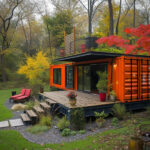Container houses have emerged as a groundbreaking trend in alternative living, offering a sustainable and eco-friendly option for modern homeowners. Constructed from repurposed shipping containers, these homes are gaining popularity due to their inherent strength, durability, and the added benefit of recycling materials that might otherwise contribute to waste.
These innovative dwellings are not only environmentally conscious but also present an affordable solution to traditional housing. The versatility of container homes allows for a range of customizations, from simple, minimalistic designs to luxurious, multi-unit residences. This adaptability, paired with the potential for lower construction costs, makes container houses an attractive option for individuals seeking a non-traditional path to property ownership.
With the increasing awareness of environmental issues and the rising cost of living, container homes provide a viable alternative that balances cost-effectiveness with a smaller ecological footprint. They challenge the norms of residential construction and open up new possibilities for sustainable development in the housing sector.

Understanding Container Homes
Container homes, known for their sustainability and affordability, are constructed from steel shipping containers. These residences leverage the strength and durability of recycled shipping containers, often recalibrating their function from global trade to innovative housing solutions.
History and Background
Shipping container homes began gaining popularity in the past few decades as a response to the need for more sustainable building practices. They emerged from the concept of reusing the abundant and structurally sound steel shipping containers that were otherwise left unused. The history of these homes is a testament to human ingenuity in repurposing industrial objects for residential use.
Design and Aesthetics
The design of a shipping container home is both a reflection of individual taste and architectural innovation. The inherently modular design allows for a high degree of customization, combining containers to create various layouts. Architects and builders can capitalize on the containers’ rectangular form, bringing a modern and industrial aesthetic to the home.
Design Features:
- Durability: Built to withstand extreme conditions of maritime transport
- Modularity: Allows for creative layouts and multi-level designs
- Aesthetics: Offers a sleek, contemporary look with corrugated steel
Types of Shipping Containers
There are primarily two sizes of containers used in building container homes: the standard 20 feet by 8 feet and the larger 40 feet by 8 feet. Each size offers a unique living space, with the smaller providing around 160 square feet and the larger, double that, at around 320 square feet.
Container Sizes:
- 20 feet by 8 feet: Perfect for smaller homes, guest houses, or studios
- 40 feet by 8 feet: Better suited for full-sized homes or larger living spaces
By capitalizing on existing shipping containers, these homes offer a path to residential spaces that prioritize recycling and innovation without compromising on strength and livability.
Planning and Preparing
Before one begins constructing a container home, careful planning and preparation are essential. This includes selecting a suitable location, understanding and adhering to local building codes, and meticulously designing the floor plan to align with one’s lifestyle and needs.
Selecting the Right Location
Choosing an appropriate location is crucial for the success of a container house project. The land should offer a stable foundation for the structures and be situated in an area that aligns with the homeowner’s living needs including accessibility, environment, and neighboring amenities.
- Zoning Laws: Research zoning laws to ensure container homes are permissible.
- Accessibility: Evaluate the ease of access for construction equipment and future living convenience.
Understanding Local Building Codes
One must comprehensively understand the local building codes as they govern the construction process and ensure safety. Local building codes can vary significantly, so obtaining clear information is vital.
- Permits: Secure the required permits which may include site plans and utility layouts.
- Approval Process: Familiarize oneself with the approval process to prevent delays.
Designing Your Floor Plan
Designing the floor plan requires careful attention to detail to maximize the space while adhering to codes and personal preferences.
- Functionality: Design each area for optimal use of space.
- Compliance: Ensure the design complies with all permit requirements and safety regulations.

Construction Details
In building a container home, attention to detail is paramount throughout the construction process. Each phase, from foundation to utilities, requires careful planning to ensure durability, comfort, and functionality.
Laying the Foundation
Choices for Foundations:
- Pier: Ideal for DIY, cost-effective, allows for airflow under the container.
- Slab: More costly, used by general contractors for permanent placement.
Before laying a foundation, one must consider the terrain and the container home’s design. Professional assessment is often necessary to determine which foundation type—pier, slab, strip, or pile—is suitable. For DIY enthusiasts, piers offer a balance of simplicity and stability. However, with additional construction costs, a general contractor may advise a concrete slab for a more permanent and durable solution.
Insulation and Climate Control
Types of Insulation:
- Spray Foam: Airtight seal, high R-value.
- Panel: DIY-friendly, affordable.
Effective insulation is critical for climate control within a container home. Choices vary from traditional batts to high-efficiency spray foam, which creates an airtight seal, though at higher construction costs. Panel insulation can be a cost-effective alternative and is a manageable task for DIY builders. Regardless of the type, proper insulation ensures a container home remains comfortable in diverse weather conditions.
Plumbing and Electricity
Utilities Installation:
- Plumbing: Requires professionals, adherence to codes.
- Electricity: Certified electrician needed, safety essential.
Plumbing and electricity installations are intricate processes that typically involve hiring professionals, as they must comply with local building codes and regulations. A general contractor ensures that the plumbing is seamlessly integrated with the structure, while a certified electrician is responsible for the safe and efficient setup of the electrical system. DIY builders must recognize the complexity of these tasks and the importance of seeking expert assistance to avoid costly errors or dangerous outcomes.

Customization and Modularity
Container homes offer remarkable opportunities for customization and modularity. They allow individuals to personalize their living spaces extensively and to expand their homes with relative ease.
Interior and Exterior Design
Container homes provide a framework for innovative design choices both inside and out. Homeowners can tailor the interior design with specific layouts for the kitchen, bathroom, and living spaces, optimizing the use of space and resources. Companies such as Backcountry Containers offer the conversion of shipping containers into unique homes that reflect an individual’s taste and needs. On the outside, the inclusion of large windows or a covered porch can alter the appearance significantly, blending the home with its surroundings or enabling it to stand out.
Expanding with Multiple Containers
The modularity of container homes facilitates expansive designs that can grow with homeowners’ needs. Through the use of multiple containers, spaces can be easily configured to create larger living areas, additional bedrooms, or specific functions like an enclosed garage. Custom container living solutions can incorporate multiple units, crafting everything from compact domiciles to sprawling multi-story residences, often faster and more efficiently than traditional home construction.
Adding Unique Features
Container homes also allow for the addition of unique features that enhance livability and functionality. Rooftop decks provide extra outdoor space, perfect for a backyard setting, offering views and a place for entertainment or relaxation. Special touches like integrated saunas, hot tubs, or cold plunges may be introduced for a luxurious twist, as seen with Kubed Living’s innovative modular designs. These options empower homeowners to create spaces that are efficient in design and rich in features.

Living in a Container Home
Container homes offer a modern, minimalist way of living, catering to individuals who prefer alternative living spaces that can range from cozy tiny houses to expansive studios. They are suited for both backcountry containers set against mountain vistas and urban environments, where space is at a premium.
Daily Living Experience
One experiences a unique indoor living area when residing in a container home, with the emphasis often on efficiency and sustainability. The interior space is typically characterized by:
- Space Optimization: Furniture and storage are frequently designed to make the most of the limited space.
- Sleek Design: Aesthetics lean towards clean lines and a minimalist styling approach.
- Connection to Outdoors: Large windows or retractable doors commonly integrate indoor and outdoor spaces, especially in homes placed in natural settings like the mountains.
Individuals might find these homes to be quite versatile, functioning efficiently as full-time residences or weekend retreats.
Maintenance and Upkeep
The upkeep of a container home is an important consideration and involves:
- Rust Prevention: Regular checking and maintenance of the outer steel structure is crucial to prevent rust, especially in areas with high humidity or salt air exposure.
- Insulation Integrity: Ensuring that insulation is intact helps maintain interior temperatures and reduces energy costs.
- Modular Repairs: Due to the modular nature of container homes, damaged sections can often be fixed or replaced with less effort compared to traditional structures.
Homeowners should be proactive in addressing these maintenance needs to enjoy a long-lasting modern home.

Advantages and Challenges
Container homes present a modern alternative in the housing market, offering both benefits and obstacles. While they stand out for their cost-effectiveness and eco-friendly prospects, navigating the legal and regulatory landscape can be complex.
Cost and Affordability
Container homes are often lauded for their cost-effectiveness, making them an accessible option for many potential homeowners. The affordability of these structures can be a significant draw, with the possibility of acquiring a basic container home starting as low as $10,000. Additionally, the investment and financing aspects can be more favorable as opposed to traditional residential and commercial buildings, given the lower initial outlay required.
Sustainability and Eco-Friendliness
The use of shipping containers as living spaces is frequently cited as a sustainable and eco-friendly option. The repurposing of these containers for housing reduces the demand for new construction materials and the carbon footprint associated with building. Moreover, their retrofitting often incorporates eco-conscious designs such as solar panels and rainwater harvesting systems, further enhancing their green credentials.
Legal and Regulatory Issues
Navigating the legal and regulatory aspects of container home construction is a recognized challenge. Both residential and commercial projects may face stringent zoning laws, building codes, and standards that can vary significantly by location. Thorough research and adequate planning are essential in order to comply with the legal requirements, and this may involve a level of complexity comparable to, or sometimes exceeding, that of traditional construction.

Beyond Homes
While container homes have become a significant trend in affordable and sustainable living, their versatility extends far beyond residential uses. Shipping containers, known for their strength and modularity, serve various commercial, recreational, and artistic purposes, demonstrating their multifaceted potential.
Container-Based Commercial Uses
Shipping containers are being repurposed as commercial spaces due to their flexibility and mobility. Architects and designers are creating luxury container shops that can easily relocate, providing business owners with unique opportunities for branding and customer engagement. Container cafes and pop-up stores have become stylish fixtures in urban settings. The adaptability of containers also extends to modular office spaces, where they can be combined to create larger areas or used as standalone units.
For those looking to venture into the hospitality industry, shipping containers have been transformed into Airbnb rentals. Their compact size makes them ideal for creating tiny home Airbnbs, providing a unique experience to travelers. These rentals often highlight the upcycled nature of the containers, featuring modern utilities such as eco-friendly gas-powered heating and cooling systems.
Creative Projects and Community Spaces
Shipping containers have also catalyzed creativity, leading to unique community spaces and art installations. They can be stacked and interlocked to create outdoor spaces for events or repurposed into container pools, offering a portable and space-efficient solution to urban areas with limited room for traditional pools.
In natural settings, container cabins provide an eco-conscious retreat, blending with their environment while offering all the comforts of a dream home. The inherent upcycled nature of using containers contributes to a sustainable lifestyle but does not compromise on style; many are quite stylish and luxurious, proving that tiny homes can still provide an upscale living experience.
Furthermore, containers have been used for artistic purposes, serving as dynamic canvases for murals or as foundational elements of interactive art exhibits, allowing both artists and visitors to engage with art in novel, accessible ways.
Their versatility ensures that as the world of architecture and design evolves, so too will the innovative applications of shipping containers in creating spaces that are not only functional but also inspiringly imaginative.

Closing Thoughts
Container homes, epitomized by Kubed Living, offer a unique blend of sustainability and modern design. They have ignited interest across the nation, with cities like Houston seeing an upswing in these innovative housing solutions. A key advantage of container homes lies in their recycling of existing materials, which resonates with environmentally conscious homeowners.
| Pros | Cons |
|---|---|
| Eases housing shortages | Requires a permanent foundation |
| Supports eco-friendly living | Limited to 320 square feet typically |
Many individuals are drawn to the portability of container homes, allowing for relocation with relative ease. Yet, this feature does not compromise the structural integrity when they are placed on a permanent foundation, signifying their potential as lasting dwellings.
Regarding space, while some may find the typical 320 square feet restrictive, clever design strategies can maximize the usage of every inch. When it comes to container homes, thoughtful planning ensures that compact living does not equate to compromised comfort.
In conclusion, the journey of building a container home requires careful consideration of the aforementioned factors. The balance between eco-friendliness and personal convenience is at the heart of this housing movement. Those intrigued by the container home lifestyle should thoroughly evaluate the implications of choosing a home that is as unique as it is pioneering.










